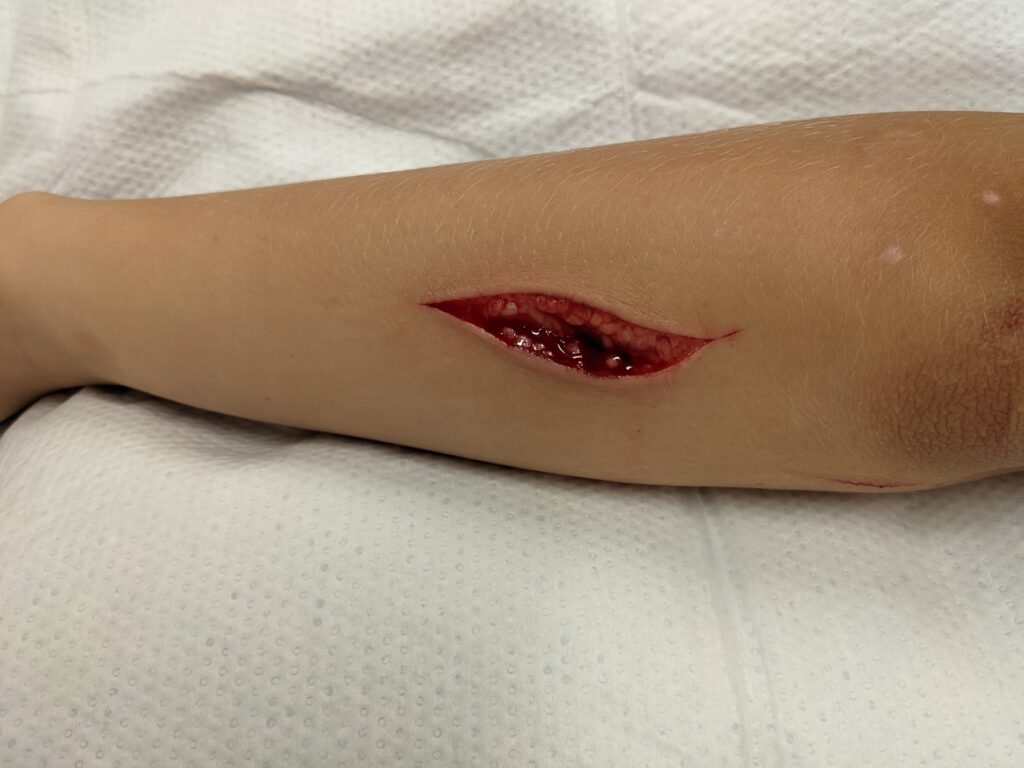
I fancy myself a good doctor. I like to think I’d be the first person you’d want if stranded on an island and you break your leg. I know a fair amount of survival stuff, but what happened recently made me rethink all that.
It’s 2 weeks ago and I’m at a family reunion in the lovely Black Hills of South Dakota. It’s a beautiful place and a great place to relax. I’m inside the cabin when I hear yelling coming from outside. My son had been feeding horses and was running to give a carrot to another one when he had his accident.
I grew up around barbed wire fence. I can climb it and go through it quickly. I know how to wrap it into a coil without injury. Sadly, I haven’t imparted this knowledge on my kids. He wasn’t even trying to get through the fence; he was simply running along it and got too close. He hits one of those barbs just right and it cuts him deep and now he’s holding his arm together with the other hand and it’s bloody and he’s running up to his Dad.
I held myself together in true ER doc fashion, to the surprise of other family members who already saw the injury. People tend to get worked up about things that are an easy fix and if the doctor panics everyone takes that lead and the situation gets worse. I calmly take his hand off the wound to find a 4-inch laceration right in the middle of his forearm running up and down. For those of you with a weak stomach, I kindly put the picture at the bottom of the post. For the rest, take a look now, then come back.
This thing is bad. It’s deep, right into the underlying tissue, the borders pulled back leaving a void that won’t heal well on its own. I immediately know what it requires: cleaning, a layer of deep absorbable stitches (the kind you don’t have to remove), then a layer of superficial stitches on the outside. Easy. I do this all the time.
Only, it requires tools. Gloves, drapes, anesthetic, needles, syringes, antiseptic, absorbable suture, polypropylene suture, sterile water, gauze, sharp scissors, a needle driver, bandaging. None of which I have in the cabin, beyond a first aid kit with gauze and bandaging. I’m completely unprepared. I’m kicking myself. I have this massive amount of knowledge and skill, but a massive void in tools.
To be sure, this isn’t a life-or-death situation, no major vessels or tendons were injured, I find as I do my examination. In a true emergency, I’d be plucking thread out of clothing and fashioning a needle out of a piece of wood or bone and stitching the kid up. I know there’ll be a scar, but I’d like it to only be large, not massive, so I want to use the best equipment I can. Defeated, I make the decision to dive him 45 minutes to the nearest ER, something an ER doc never, NEVER does.
We Don’t Go to the ER
As I’m driving, kid with a gauze bandage on his arm, I’m thinking about why going to the ER is such a big deal for me. As a doc, I see many people who are sick and having emergencies. I see just as many, or more, who don’t really have an emergency, but have no other place to go, no money, or see the ER as a convenience center. I gladly take care of these people, but I regret when it takes me away from others with true emergencies and I lament that the system failed those without true emergencies. Those of us who see this happen daily have a deep concern with becoming a patient who inadvertently prevents some other more worthy patient from being seen timely. Irrational? Possibly. But it’s reality. Talk with damn near any ER doc or nurse and you’ll hear something similar.
Part of it is Authority. I believe I would be the best person to stitch up this laceration. I’ve been to school, residency, and have 15 years of putting 10,000 stitches into terrified people’s body parts. I keep that Authority for myself and shouldn’t have to bother some other doc or delay some other patient with abdominal pain or a broken leg. That’s why it galls me that in this instant, I know everything there is to know about the problem, but I’m still completely unprepared.
We make it to the amazing ER in Custer and are treated expertly by the nurses and physician, despite it being a busy afternoon for the staff. A great experience, considering. As we drive back by the numerous rental cabins owned by savvy investors making thousands of dollars from family reunions, weddings, and other vacationers, I can’t help thinking about how knowledge is one thing required, but tools are another. We arrive back in time to visit with family and tell them our story. My car now has every bit of kit needed for expert first aid and a lot of definitive care so we hopefully can avoid a similar event in the future.
Avoid the Void
When a person asks me where to begin in their real estate journey, I often give them some reading assignments. I tell them to gain knowledge. Perhaps take a course. Network with people. Gain a mindset needed to achieve their goals. These things will only get you so far. Here are some tools that you need, without which you have knowledge but a huge void, and can’t get to where you are going.
- Computer with Spreadsheet. Spreadsheeting. You either love it or hate it. If you hate it, find someone to help you who does. There’s all kind of specialized software out there that claim to do real estate for you, and someday you’ll use one, but today is about inexpensiveness. Microsoft Excel or Google Sheets are the way to go here. Keep everything on here: A list of books you want to read and have read, your personal financial statement, your (growing) list of properties owned and sold, a master rent roll, a list of bank account numbers (controversial, as this would be bad if gotten in the wrong hands), your own sheet for evaluating deals (I created mine from the excellent The Millionaire Real Estate Investor by Keller and Papasan), and everything else.
- Email that you actually pay for. Nothing says ‘amateur’ more than an email with [yourname]@yahoo.com or any number of other free domains. Even less expensive is to use free email that hooks to a paid domain. I use and love Fastmail.com (not a sponsor).
- A Team. Real estate agent, banker, insurance agent, and lawyer. Also consider a property manager. When first starting, you may find the property manager too expensive, but make the switch fast. It takes too much of your valuable time to be in the weeds of management.
- Business Cards. Also a controversial one. It’s the information age! Why do we still need these? They are inexpensive and can look great. You should be networking and undoubtedly someone will ask you for your card. You should be prepared. A card lends a certain amount of credibility you can’t get otherwise. It says you are serious about your business.
- Access to Cash. Before you get really in depth about investing, you should have a way to get cash quickly. Tools here are your banker, a line of credit, friends and family, a fat bank account (you lucky dog), or a hard money lender. Many people skip this important tool. When they get a deal, they can’t purchase it. A terrible feeling.
- A Mastermind Group. Find some people at a similar stage in their investing, who have similar real estate goals. Meet with them weekly to discuss your projects. This group is the #1 thing I credit with keeping me going through the setbacks and distractions in life.

Read further if you would like to see the laceration that sent us to the ER. It’s a little rough for some people. You’ve been warned.

I find it…disarming.
